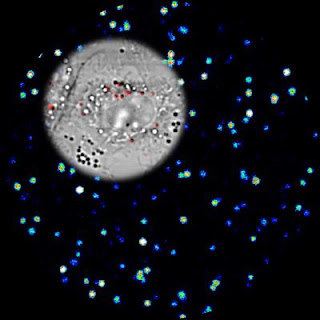WEST LAFAYETTE, Ind. - New research findings suggest that an experimental ultrasensitive medical imaging technique that uses a pulsed laser and tiny metallic "nanocages" might enable both the early detection and treatment of disease.
The system works by shining near-infrared laser pulses through the skin to detect hollow nanocages and solid nanoparticles - made of an alloy of gold and silver - that are injected into the bloodstream.
Unlike previous approaches using tiny metallic nanorods and nanospheres, the new technique does not cause heat damage to tissue being imaged. Another advantage is that it does not produce a background "auto fluorescent" glow of surrounding tissues, which interferes with the imaging and reduces contrast and brightness, said Ji-Xin Cheng (pronounced Gee-Shin), an associate professor of biomedical engineering and chemistry at Purdue University.
Previous research to develop the imaging system has required the use of "plasmons," or clouds of electrons moving in unison, to enhance brightness and contrast. However, using plasmons generates tissue-damaging heat. The new technique does not use plasmon enhancement, eliminating this heating, Cheng said.
The three-photon effect might enable scientists to develop advanced "non-linear optical techniques" that provide better contrast than conventional technologies.
"The three-photon imaging capability will potentially allow us to combine imaging and therapy for better diagnosis and monitoring," Xia said.
Researchers used a laser in the near-infrared range of the spectrum pulsing at the speed of femtoseconds, or quadrillionths of a second. The laser pulses 80 million times per second to illuminate tissues and organs after nanocages have been injected, Cheng said.
The cages and particles are about 40 nanometers wide, or roughly 100 times smaller than a red blood cell.
The researchers intravenously injected the nanocages into mice and then took images of the tiny structures in tissue samples from organs such as the liver and spleen. ###
The ongoing research is funded by the National Science Foundation and the National Institutes of Health. The research also is affiliated with the Birck Nanotechnology Center and the Bindley Bioscience Center, both in Purdue's Discovery Park.
Ji-Xin Cheng: engineering.purdue.edu/BME/Research/Labs/Cheng
Weldon School of Biomedical Engineering: www.purdue.edu/bme
Younan Xia: engineering.wustl.edu/facultybio
Abstract on the research in this release is available at: www.purdue.edu/newsroom/research/ChengNanocages
Contact: Emil Venere venere@purdue.edu 765-494-4709 Purdue University















No comments:
Post a Comment